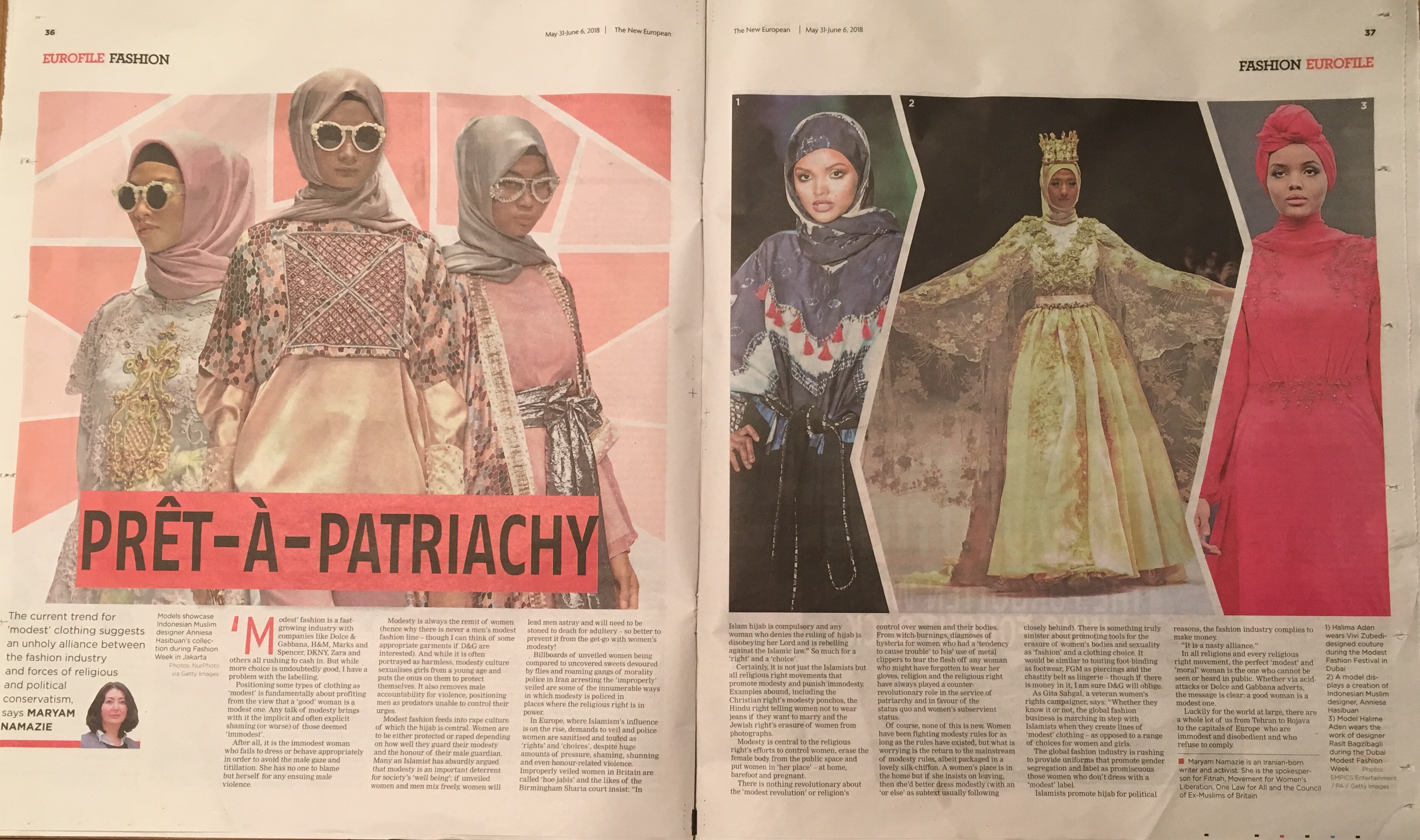The below was published in The New European on 31 May 2018
“Modest” fashion is a fast growing industry with companies like Dolce & Gabbana, H&M, Marks and Spencer, DKNY, Zara and others all rushing to cash in. But while more choice is undoubtedly good, I have a problem with the labelling.
Positioning some types of clothing as “modest” is fundamentally about profiting from the view that a “good” woman is a modest one. Any talk of modesty brings with it the implicit and often explicit shaming (or worse) of those deemed “immodest”. After all, it is the immodest woman who fails to dress or behave appropriately in order to avoid the male gaze and titillation. She has no one to blame but herself for any ensuing male violence.
Modesty is always the remit of women (hence why there is never a men’s modest fashion line — though I can think of some appropriate garments if D&G are interested). And while it is often portrayed as harmless, modesty culture sexualises girls from a young age and puts the onus on them to protect themselves. It also removes male accountability for violence, positioning men as predators unable to control their urges.
Modest fashion feeds into rape culture of which the hijab is central. Women are to be either protected or raped depending on how well they guard their modesty and the honour of their male guardian. Many an Islamist has absurdly argued that modesty is an important deterrent for society’s “well being”; if unveiled women and men mix freely, women will lead men astray and will need to be stoned to death for adultery so better to prevent it from the get go with women’s modesty!
Billboards of unveiled women being compared to uncovered sweets devoured by flies and roaming gangs of morality police in Iran arresting the “improperly” veiled are some of the innumerable ways in which modesty is policed in places where the religious-Right is in power. In Europe, where Islamism’s influence is on the rise, the demand to veil and police women are sanitised and touted as “rights” and “choices” despite huge amounts of pressure, shaming, shunning and even honour-related violence. Improperly veiled women in Britain are called “hoe-jabis” and the likes of the Birmingham Sharia court insist: “In Islam hijab is compulsory and any woman who denies the ruling of hijab is disobeying her Lord and is rebelling against the Islamic law”. So much for a “right” and a “choice.”
Certainly, it is not just the Islamists but all religious-Right movements that promote modesty and punish immodesty. Examples abound, including the Christian-Right’s modesty ponchos, the Hindu-Right’s telling women not to wear jeans if they want to marry and the Jewish-Right’s erasure of women from photographs.
Modesty is central to religion’s and the religious-Right’s efforts to control women, erase the female body from the public space and put women in “her place” – at home, barefoot and pregnant.
There is nothing revolutionary about the “modest revolution” or religion’s control over women and their bodies. From witch-burnings, diagnoses of hysteria for women who had a “tendency to cause trouble” to ISIS’ use of metal clippers to tear the flesh off any woman who might have forgotten to wear her gloves, religion and the religious-Right have always played a counter-revolutionary role in the service of patriarchy and in favour of the status quo and women’s subservient status.
Of course, none of this is new. Women have been fighting modesty rules for as long as the rules have existed but what is worrying is the return to the mainstream of modesty rules, albeit packaged in a lovely silk-chiffon. A women’s place is in the home but if she insists on leaving, then she’d better dress modestly (with an “or else” as subtext usually following closely behind).
There is something truly sinister about promoting tools for the erasure of women’s bodies and sexuality as “fashion” and a clothing choice. It would be similar to touting foot-binding as footwear, FGM as piercings and the chastity belt as lingerie – though if there is money in it, I am sure D&G will oblige.
As Gita Sahgal, a veteran women’s rights campaigner, says: “Whether they know it or not, the global fashion business is marching in step with Islamists when they create lines of ‘modest’ clothing – as opposed to a range of choices for women and girls. The global fashion industry is rushing to provide uniforms that promote gender segregation and label as promiscuous those women who don’t dress with a ‘modest’ label. Islamists promote hijab for political reasons, the fashion industry complies to make money. It is a nasty alliance.”
In all religions and every religious-Right movement, the perfect “modest” and “moral” woman is the one who cannot be seen or heard in public. Whether via acid-attacks or Dolce and Gabbana adverts, the message is clear: a good woman is a modest one.
Luckily for the world at large, there are a whole lot of us from Tehran to Rojava to the capitals of Europe who are immodest and disobedient and who refuse to comply.

Leave a Reply